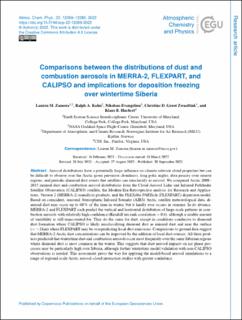| dc.contributor.author | Zamora, Lauren M | |
| dc.contributor.author | Kahn, Ralph A. | |
| dc.contributor.author | Evangeliou, Nikolaos | |
| dc.contributor.author | Zwaaftink, Christine Groot | |
| dc.contributor.author | Huebert, Klaus B | |
| dc.date.accessioned | 2022-10-11T07:14:23Z | |
| dc.date.available | 2022-10-11T07:14:23Z | |
| dc.date.created | 2022-10-04T10:33:25Z | |
| dc.date.issued | 2022 | |
| dc.identifier.citation | Atmospheric Chemistry and Physics (ACP). 2022, 22, 12269-12285. | en_US |
| dc.identifier.issn | 1680-7316 | |
| dc.identifier.uri | https://hdl.handle.net/11250/3025241 | |
| dc.description.abstract | Aerosol distributions have a potentially large influence on climate-relevant cloud properties but can be difficult to observe over the Arctic given pervasive cloudiness, long polar nights, data paucity over remote regions, and periodic diamond dust events that satellites can misclassify as aerosol. We compared Arctic 2008–2015 mineral dust and combustion aerosol distributions from the Cloud-Aerosol Lidar and Infrared Pathfinder Satellite Observation (CALIPSO) satellite, the Modern-Era Retrospective analysis for Research and Applications, Version 2 (MERRA-2) reanalysis products, and the FLEXible PARTicle (FLEXPART) dispersion model. Based on coincident, seasonal Atmospheric Infrared Sounder (AIRS) Arctic satellite meteorological data, diamond dust may occur up to 60 % of the time in winter, but it hardly ever occurs in summer. In its absence, MERRA-2 and FLEXPART each predict the vertical and horizontal distribution of large-scale patterns in combustion aerosols with relatively high confidence (Kendall tau rank correlation > 0.6), although a sizable amount of variability is still unaccounted for. They do the same for dust, except in conditions conducive to diamond dust formation where CALIPSO is likely misclassifying diamond dust as mineral dust and near the surface... | en_US |
| dc.language.iso | eng | en_US |
| dc.rights | Navngivelse 4.0 Internasjonal | * |
| dc.rights.uri | http://creativecommons.org/licenses/by/4.0/deed.no | * |
| dc.title | Comparisons between the distributions of dust and combustion aerosols in MERRA-2, FLEXPART, and CALIPSO and implications for deposition freezing over wintertime Siberia | en_US |
| dc.title.alternative | Comparisons between the distributions of dust and combustion aerosols in MERRA-2, FLEXPART, and CALIPSO and implications for deposition freezing over wintertime Siberia | en_US |
| dc.type | Peer reviewed | en_US |
| dc.type | Journal article | en_US |
| dc.description.version | publishedVersion | en_US |
| dc.rights.holder | © Author(s) 2022. | en_US |
| dc.source.pagenumber | 12269-12285 | en_US |
| dc.source.volume | 22 | en_US |
| dc.source.journal | Atmospheric Chemistry and Physics (ACP) | en_US |
| dc.identifier.doi | 10.5194/acp-22-12269-2022 | |
| dc.identifier.cristin | 2058224 | |
| dc.relation.project | Norges forskningsråd: 275407 | en_US |
| dc.relation.project | NASA National Aeronautics and Space Administration: 80NSSC19K0978 | en_US |
| dc.relation.project | NILU - Norsk institutt for luftforskning: 118063 | en_US |
| cristin.ispublished | true | |
| cristin.fulltext | original | |
| cristin.qualitycode | 2 | |

